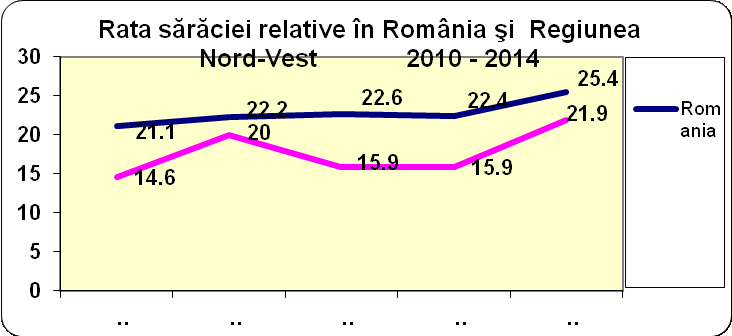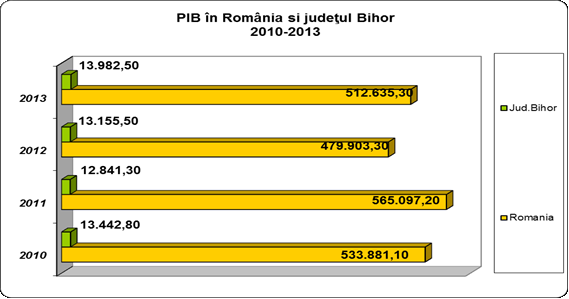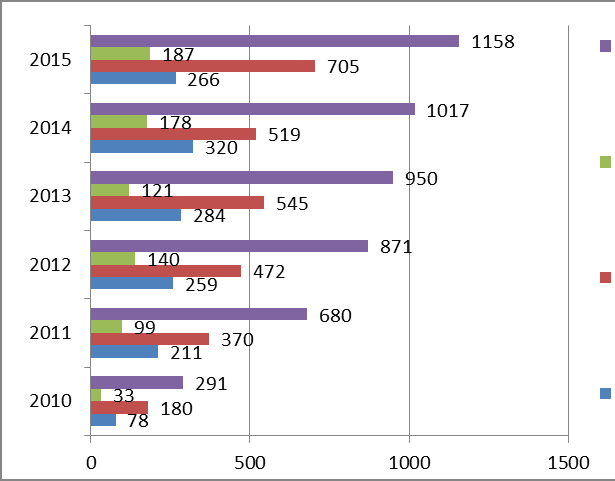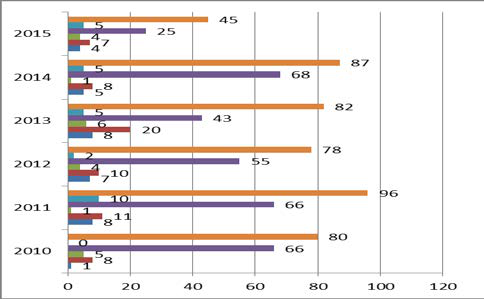The Effects of Migration to EU Countries in the Case of Active Population in the North-West Region, Romania
Abstract
This paper approaches the causes and effects of human and labour force migration, two highly dynamic phenomena generated by globalization and the loss of stability caused by political and social conflicts from countries with low standards of living and social security. Globally, remittances to developing countries rose in 2014 by 6.3%, i.e. USD 414 billion, this sum rising to EUR 540 billion by 2016, according to the World Bank. The Romanian migration to the Western countries requires a comprehensive and complex approach. The data analysed here regards the North-West Region of Romania, especially the case Bihor County. Oficially, this migration reaches low levels, i.e. about 200.000 persons. Though, the illegal one is appreciated to reach 1.7 to 2.3 million persons. Its effects are mainly due to the loss of tax payers, the weakening of social solidarity in the social security system, the remittance of important amounts of money in the origin countries, the contact with other economic, social, or cultural models. At the same time, the effects of migration on families, especially on children left at home, have material and social consequences, affecting both the individual and community, this problematic situation requiring, in order to be solved, a complex approach.
Keywords: migrationsocial conflictsactive labour forceparentsmigrantschildren
Introduction
Socio-economic crises, armed conflicts from different parts of the world, as well as the instability of
socio-economic policies often reformed, were determinative causes of migration from more vulnerable,
less developed countries, to other countries, in the hope of achieving a better life. Migration involves
territorial mobility, the change of the place of origin and even that of the residence, leading at the same
time to the change of social status of migrant persons. The scale and diversity of changes over the last
25 years in the contemporary world have affected, in different ways, Romania as well, bringing
profound changes in the political, economic, social, demographic, technological and cultural fields. The
economic and financial crisis that started in the United States of America in September 2008 involved
most countries, including countries from the European Union, among which Romania. In this context,
it is to be noted that the member states of the European Union have had to face the need for economic
growth and the modernization of the labour market. These are ensured inclusively by measures related
to the mobility of the labour force that may become available at a given moment in other countries,
where constraints related to the restructuring of the labour market and the loss of jobs may still exist.
At the same time, the need to develop social security systems on national, as well as community level,
is to be remarked, as an effect of economic causes, the increasing level of aging population, (based on
the continuous decrease of childbirth), and the generation of active population within the European
Economic Area. Migration is an "entirely social phenomenon" through which opportunities and
problems, history, present and future may be "read" at the level of Romanian society As Sandu
correctly observes, for Romanians emigration has become the preferred way to a quicker social
transition (Sandu, 2010, p. 35). The interest of the destination countries towards immigrants resides in
the fact that they constitute a considerable resource, accessible and cheap at the same time. Besides
covering the lack of physical labour shortages, the significant contribution of migrants to ensure the
sustainability of social security systems in destination countries has to be appreciated, now and in the
future as well. The phenomenon of migration has gained amplitude throughout the last decades, due to
the fact that countries and regions with a more fragile and less efficient economy began to confront
both the negative effects (generated by their economic restructuring and tensions of social nature that
affected a large part of the population), as well as the opening of migration opportunities, especially to
Western countries, as it is the case of Romania. Based on these, the population migration has lately
gained large proportions, with unprecedented dynamics and structure, affecting the population of
Romania, including the North-West Region. Romanian migration has become one of the main
migrations from the East towards the West of Europe, and its approach and treatment requires a
comprehensive vision and approach, especially on national level, taking into consideration the effects
of this phenomenon on short and long term. The migration phenomenon, generating effects on the
emigrants, on their family and local and national communities, would require adequate economic and
social policies. Negative economic effects of migration on the national level consist mainly in the loss
of tax payers, accompanied by the loss of the active labour force which was formed in Romania. In the
case of an individual, the positive effects of migration are materialized mainly by gaining professional
income, as well as revenues that pertain to the benefits of social security, in order to ensure the
necessary resources for achieving a standard of living for those directly involved and for their families.
Nonetheless, the benefits earned by emigrants from experiences gained through their contacts with
other economic, social, cultural models must be remarked, as well as the benefit of becoming a resident
in the countries of residence. Thus, the possibility of becoming beneficiaries of national social security
systems, of the community, is open to the immigrants. Moreover, the positive effects of emigration on
family the families involved are manifested by remitting a large sum of money to the country of origin.
Remittances sent home by Romanian migrants working abroad range from a minimum of 2.72 billion
euros in 2014 (according to the World Bank), while transfers in 2015 were at 3.3 billion euros, as
reported by the National Bank of Romania (http://www.economica.net/). According to data from the
National Statistics Institute, more than 2.37 million Romanians work abroad, and many of them have
formed families there. It can be inferred that the migration of the active population - and especially that
of the youth - produces effects on the short and long term budgets from which the taxpayer who left
their country of origin is missing.
Economic Causes of the Population’s Migration
Justifying migration through economic causes is confined mainly to the effects of a GDP growth
below expectations. The growth of the national level poverty rate, its differentiation at territorial levels
presented below, and the existence of a socio-economic climate with weakly incentivized valences
have also to be taken into account.
The increased cost of living due to the decrease of the labour market and the restructuring of the
labour force demand, job losses by a significant number of persons and the challenges triggered by the
need to improve the standard of living are essential causes that motivated the external migration of the
Romanian population. Opportunities open for active domestic labour force on foreign labour force
markets, gaining additional income, and the possibility of achieving better material welfare in the
countries of destination, as well as the fact of being able to support the family of origin left at home -
all these motivate the people to migrate. Positive experiences of the migrants, the development of
entrepreneurial skills, and the possibility of making full use of the resources and markets that can be
accessed, which is a consequence of the guaranteed freedoms in the community area, are the important
benefits of migration.
Social Effects of Migration
The family, as a fundamental unit of society, aims to ensure, by parents - through the exercise of
functional parental responsibility, by consequently assuming specific risks - the necessary livelihood
for its members, particularly those related to the care and harmonious development of children. Due to
material constraints on the family, and the poor information of parents who move abroad, there is a
tendency of these persons to prioritize issues of economic nature to those involving children's rights,
especially those related to their upbringing, education and psycho-affective development within the
family. Parents who are in this situation, due to objective or subjective reasons, tend not to give
sufficient importance to the social problems of the family members, the situations of family risk that
may lead to the damaging of the family environment, and the quality of family relationships. This
prioritization of parental behaviours may cause hardly surmountable effects on the child. Providing
emotional support, schooling, child education, participation and skill development necessary for
independent living are indispensable needs for the normal development of a child. When parents ignore
or approach superficially these needs of children, as well as the risk situations, problems as neglect,
abuse, school dropout, vagabondage, human trafficking, labour exploitation, crime, and the danger of
marginalization or social exclusion may be facilitated. Obviously, all these require the intervention of
the state institutions specialized in ensuring children's rights and institutionalization. In the framework
set by the migration phenomenon, one often encounters the effects of a disorganized family, where
parents neglect, abuse or even abandon the minor. The age when the child is disadvantaged by negative
life experiences have, in turn, a decisive role. The lower the age of the child, the greater the effects of
these parental or environmental influences, foreshadowing disharmonic features.
Research Aims and Methodology
The aim of the research is to approach critically the phenomenon of parents migration in the case of
the North-West Region, Romania, in order to provide the guide marks for an efficient intervention
strategy focused on promoting the best interests of the child. In this respect, the first part of this paper
presents the amplitude/ dimensions, the main causes, and the effects of this migration, by which so
many parents left their children at home, in order to work in the countries of Western Europe. In
addition to this, the intervention of the specialized public institutions in the field of protection of
children’s rights and the insurance of child protection in risk situations, as well as the financial effects
of the takeover of these children into the county’s child welfare system, is also depicted, in order to
identify efficient solutions to the problems that affect the well-being of children, generated by parents
migration. The methodology used is based on the quantitative and qualitative analysis of the migration
phenomenon in the light of its determining causes in Romania, extended to the level of the North-West
Region, especially the case of Bihor County. Moreover, the interview, as a method of qualitative
research, was applied to the specialists working in the field of education and social protection for
children. The collected data originates from central and local institutions with competence in the
researched domain, i.e. the National Statistics Institute, County Statistics Directorate, and the General
Directorate of Social Assistance and Child Protection Bihor. The processing of quantitative and
qualitative data has been performed by the author.
Research of the Effects of Migration on Children in the Case of Parents Departed for Work
for a Prolonged Period of Time from the North-West Region, Romania
In order to track as suggestively as possible the causes of the population’s emigration, we quote the
following statement regarding the evolution of the relative poverty rate and gross domestic product
(GDP), as follows:

Source: NSI – National Statistics Institute
It can be concluded that, in the last five years, the degree of relative poverty has reached high levels
in Romania, being in a continuing increase. In the North-West Region, where Bihor County lies, the
degree of the relative poverty level is lower, with oscillating values, tending closer to the national level.
Analysis of GDP in Romania and Bihor County between 2010 and 2013 is as follows:

Source: NSI – National Statistics Institute
It can be concluded that between 2010 and 2013, in Romania, both on national and Bihor County
level, GDP has values that do not determine a continuous increase. Rather, it reaches oscillating annual
values, with tendencies not to follow the same trend of annual evolution at county level, in comparison
to the national one. In the chart below, we present the situation of the children from Bihor County
whose parents have left for work abroad between 2010 and 2015:

Source : General Directorate of Social Assistance and Child Protection of Bihor County (□ = Total number of children; □ = Number of children from single-parent familieswhose unique parent has left for work abroad; □ = Number of children from families where one parent has left for work abroad; □ = Number of children from families where both parentshave left for work abroad)
It can be concluded from this dynamic analysis that there is a growing number of children left
behind at home. In the case of most families - 705 cases, out of a total of 1158 registered in 2015, one
parent remained at home with the children. 453 cases registered in 2015 concern children left behind
with neither of their parents, this number of cases resulting from the departure of 187 parents from
single-parent families, and 266 children with both parents gone to work abroad. In order to characterize
the effects of migration on children in terms of cases of neglect, we present below the situation of
abuse, neglect and exploitation confirmed in Bihor County in the period between 2010 and 2015:

Source : General Directorate of Social Assistance and Child Protection of Bihor County (□ = Total of cases; □ = Behavioral disorders;□ = Neglect/ Exploitation; □= Sexual abuse; □ = Physical abuse; □ = Emotional abuse) It appears that in the first 5 years the number of cases of abuse, neglect and exploitation among
children in Bihor County has reached annual rates with insignificant violations, their average being 85
cases, and in 2015 a significant decrease, reaching the number of 45 cases. In all these cases the
intervention of authorities was necessary and specific measures of child protection were taken. The
data provided by the County School Inspectorate, registered for the period between the years 2014 and
2015, shows a number 544 dropouts, of which: 423 cases from primary education, 121 cases from
secondary education. These 544 dropouts comprises 135 cases registered in urban areas and 419
registered in rural areas. In Bihor County, the intervention of specialized public institutions regarding
the protection of children in risk situations is organized through the General Directorate of Social
Assistance and Child Protection, as a specialized public institution for the protection of abused,
neglected, and exploited children. The General Directorate includes in its organizational structure a
specialized intervention service for urgent intervention on the protection of children’s rights in a risk
situation. The specialized intervention service cooperates with other public institutions and private
organizations, performing specific assessment and intervention concerning children from the streets,
abused, neglected, and exploited children, the child victims of human trafficking, repatriated children,
children in the situation of illegal migration, those who commit criminal acts and are not criminally
responsible, as well as the victims of domestic violence. The service performs coordination and
guidance of activities carried out at specialized centres of intervention or the Emergency Reception
Centre for abused, neglected, and exploited children, Day and Night time Shelter for Children from the
Street, Child Helpline for reporting cases of emergency, and the Centre of Counselling and Support for
parents and children. The service also performs specific activities regarding the protection of children’s
rights in the situation of court decision enforcements related to minors. The financial effects, at the
level of Bihor County, of migrant parents whose children had been left behind at home and have been
taken over into the child welfare system throughout the year 2015, meant a budgetary effort of approx.
RON 2.3 million (source: General Directorate of Social Assistance and Child Protection – Bihor
County).
Conclusions
The absence of parents, of a nurturing environment, induces the lack of normal emotions in the
child, which may cause delays in their physical development, the emerging of behavioural disorder,
and even mental retardation. The effects of a disorganized family produce an emotional and social
imbalance on the children.
The precarious development of family relations affect the entire psychological development of the
child, which may have negative consequences throughout their whole life, inhibiting personal
development and social relations. In 2004, Law no. 272 was adopted, updated in 2014, on the
protection and promotion of child rights, which comply closely with the Convention on the Rights of
the Child and expands the scope of protection of children in difficulty to child rights protection.
The abandonment of children by migrant parents, the fact of leaving them behind at home, produces
negative effects on the long term, inducing syncopated perspectives of development. These effects
appear in the process of education, apprenticeship, gaining of habits for an independent life, health
conditions, and ultimately, in their chances of socio-economic integration. Government Decision no.
691/2015 describes the procedure for monitoring the growth and care of children whose parents work
abroad, and those who returned home after a stay abroad with their parents longer than one year.
Poverty and job insecurity are the main causes of labour force migration. The consequence consists
in the existance of significant differences between opportunities offered by labour force markets in the
countries of destination (mainly in Western Europe), the incomes being significantly greater as those
in gained in Romania. That is why we consider that, on the national level, the promotion of adequate
socio-economic policies, that would motivate development instead of migration, would be necessary.
Simultaneously, we consider that repatriation policies would have to be elaborated and promoted in
order to make the former Romanian emigrants to return home during their active years, in the benefit of
their families and Romanian society, by making full use of the experiences they gained abroad.
Moreover, we consider that, in order to inform the potential migrants on children’s rights and the
specific measures of child protection, that can be accessed locally and community-wise, a national
campaign should be started. By observing the span of negative effects of the phenomenon, we note that
the specialized state institutions manage to solve only partially – that means the emergency situations -
the cases of children exposed to risk situations. Currently, the budgetary effort presented earlier,
although consistent, the necessity of improving the identification and development measures of a
support system for the families of children left behind at home, involving their education and socio-
professional integration into Romania’s labour market, still persists. In this regard, Social Assistance
Law no. 292 / 2011 mentions the possibility of organizing social services in integrated system, next to
the fields of employment, health and education (Law of Social Assistance 292/2011). Considering the
amplitude of the phenomenon, it is necessary to raise awareness among those involved directly.
Subsequently, political forces, local community administrations and civil society should be mobilized
as well, in order to prevent and treat the negative effects of migration.
References
- Government Decision No. 691 of 19.08.2015. for the approval of the monitoring procedure of the modalities of child upbringing, with parents employed abroad.
- Law No. 272/2004 regarding protection and promotion of children’s rights, republished in 2014.
- Sandu, D. (2010). Social Worlds of Romanian Migration Abroad. Bucharest: Polirom.
- Surpriză: Muncitorii români din Anglia au trimis mai mulţi bani acasă decât cei din Spania şi Italia. (March, 22, 2016). Retrievede from: http://www.economica.net/surpriza-muncitorii-romani-din-anglia-au-trimis-maimulti-bani-acasa-decat-cei-din-spania-si-italia_116680.html#ixzz44JkM7dfU, accessed on 31.03.2016.
- The Law of Social Assistance 292 from 20th December 2011, published in Romania’s Official Gazette No. 905 from 20th December 2011.
Copyright information

This work is licensed under a Creative Commons Attribution-NonCommercial-NoDerivatives 4.0 International License.
About this article
Publication Date
04 October 2016
Article Doi
eBook ISBN
978-1-80296-014-3
Publisher
Future Academy
Volume
15
Print ISBN (optional)
-
Edition Number
1st Edition
Pages
1-1115
Subjects
Communication, communication studies, social interaction, moral purpose of education, social purpose of education
Cite this article as:
Szarka, A. (2016). The Effects of Migration to EU Countries in the Case of Active Population in the North-West Region, Romania. In A. Sandu, T. Ciulei, & A. Frunza (Eds.), Logos Universality Mentality Education Novelty, vol 15. European Proceedings of Social and Behavioural Sciences (pp. 993-1000). Future Academy. https://doi.org/10.15405/epsbs.2016.09.123

